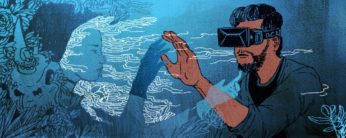
By: Etahjayne Harris,
“Virtual Reality (VR) is the use of computer technology to create a simulated environment. Unlike traditional user interfaces, VR places the user inside an experience.”[1] With virtual technology, a user can be transported to a destination of their choice in an instant. Today, virtual reality is increasingly becoming part of our actual reality.[2] For example, “[t]he virtual world Second Life is populated by 1 million people on a daily basis, and there are expected to be as many as 171 million active VR users by 2018.”[3] Companies like Microsoft Corp., Sony Corp., Facebook, Inc. and Samsung Electronics Co. Ltd., are major investors in this emerging technological field.[4] The number of virtual reality devices sold is projected to rise from 2.5 million units in 2016 to 24 million units in 2018. [5] Today, consumers may experience virtual worlds through products like Google Cardboard glasses, Samsung VR, and the Facebook owned Oculus Rift.[6]
Accurate environmental sounds and visual characteristics are essential to creating a truly lifelike virtual reality experience.[7] “As virtual worlds continue to grow in scope and popularity, they also become inextricably linked with the real world.”[8] The need to create realistic, immersive virtual worlds necessarily means using multisensory effect designs (touch, appearance, sound, smell, taste). Do intellectual property rights like trademark rights extend to multisensory effect designs in virtual worlds?
Currently, intellectual property rights do not extend to multisensory effect designs in virtual reality worlds; but they should. Multisensory effect designs are what make virtual worlds seem more like the real world. Environmental elements like touch, taste, sound, smell, and appearance are very important in real life so it follows that these multisensory effects would be essential to creating quality immersive virtual reality experiences. Can these virtual reality multi-sensory effect designs be protected under trade dress? “Trade dress is a specific type of trademark.”[9] Under the Lanham Act, trademark protection extends to, “any word, term, name, symbol, or device” that “is likely to cause confusion, or to cause mistake, or to deceive” as to the source of a product.”[10] This is a very broad standard. In order to get trademark protection, a word, term, name, symbol, or device must be distinctive and used in commerce.[11] A trademark is considered distinctive if consumers recognize the mark as an indicator of the product source, such that they can use it to distinguish one producer’s product from another. [12] Thus, trade dress protection is limited to, “the meaningful use of a mark in a trade or business.”[13] Furthermore, [i]f the trade dress is not inherently distinctive, it can be protected only if, as a result of use, it has acquired secondary meaning in the marketplace.”[14]
“[W]hether a VR sensory scheme will be categorized as product design or packaging will have profound implications in its trade dress eligibility.”[15] If the Lanham Act requirements are satisfied, a virtual reality business owner may be afforded protection over multisensory effect designs that are either inherently distinctive or have acquired distinctiveness attributable to their business over time. The test for trade dress infringement is, “whether there is a likelihood of confusion resulting from the impression created by the defendant’s accused trade dress.”[16] So if the virtual reality business owner has a valid trademark in their multisensory effect design, he or she would be able to bring a claim against another virtual reality business owner that, “inappropriately used the mark in a way that generates consumer confusion.”[17]
The courts have not yet decided whether multisensory effect designs are protected under current trademark law. As of today, these designs are not protected under intellectual property law. As virtual reality gains in popularity and becomes more widespread, it will be important for the courts to resolve this issue.
[1] Brian Jackson, What is Virtual Reality? [Definition and Examples] Marxentlabs (2015), http://www.marxentlabs.com/what-is-virtual-reality-definition-and-examples/ (last visited Nov 30, 2016).
[2] See Jonathan M. Purow, Virtual Reality May Create Novel IP Issues In The Real World Law360 (2016), http://www.law360.com/articles/769479/virtual-reality-may-create-novel-ip-issues-in-the-real-world (last visited Nov 30, 2016).
[3] Id.
[4] See id.
[5] See id.
[6] See id.
[7] See Brian Jackson, What is Virtual Reality? [Definition and Examples] Marxentlabs (2015), http://www.marxentlabs.com/what-is-virtual-reality-definition-and-examples/ (last visited Nov 30, 2016).
[8] Erez Reuveni, ARTICLE: On Virtual Worlds: Copyright and Contract Law at the Dawn of the Virtual Age, 82 Ind. L.J. (2007).
[9] Ellii Cho, Copyright or Trade Tress? Toward IP Protection of Multisensory Effect Designs for Immersive Virtual Environments, Cardozo Arts and Entertainment Journal, 823 (2016).
[10] 15 U.S.C. § 1125(a) (2012).
[11] See Abercrombie & Fitch Stores, Inc. v. American Eagle Outfitters, Inc., 280 F.3d 619, 630 (6th Cir. 2002) (“Because we can conceive of no ‘thing’ inherently incapable of carrying meaning, any ‘thing’ can come to distinguish goods in commerce and thus constitute a mark within the meaning of the Lanham Act.”).
[12] See Inwood Labs., Inc. v. Ives Labs., Inc., 456 U.S. 844, 851 n.11 (1982).
[13] See Abercrombie & Fitch Stores, Inc. v. American Eagle Outfitters, Inc., 280 F.3d 619, 630 (6th Cir. 2002) (“Because we can conceive of no ‘thing’ inherently incapable of carrying meaning, any ‘thing’ can come to distinguish goods in commerce and thus constitute a mark within the meaning of the Lanham Act.”).
[14] Ellii Cho, Copyright or Trade Tress? Toward IP Protection of Multisensory Effect Designs for Immersive Virtual Environments, Cardozo Arts and Entertainment Journal, 824 (2016).
[15] See id.
[16] J. Thomas McCarthy, MCCARTHY ON TRADEMARKS AND UNFAIR COMPETITION § 8:1 (4th ed. 2014).
[17] Ellii Cho, Copyright or Trade Tress? Toward IP Protection of Multisensory Effect Designs for Immersive Virtual Environments, Cardozo Arts and Entertainment Journal, 824 (2016).
Image Source:
https://broadly-images.vice.com/images/articles/meta/2016/07/14/virtual-reality-1468505507.jpg?crop=1xw:1xh;center,top&resize=2000:*&output-quality=70
